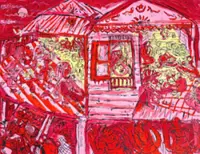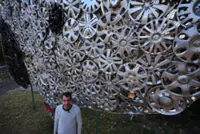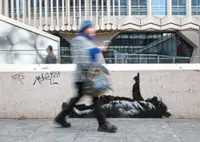'When working through doubt, I often find focus. Conversely, in moments of supposed certainty, I encounter doubt. This paradox reveals that opposites are not separate entities but intertwined forces that shape and challenge each other,' says Lam about his new exhibition. Photo: Wei-Ling Gallery
If contemporary artist Ivan Lam wandered through the trendiest streets of downtown Kuala Lumpur, he’d slip seamlessly into the rhythm of the city - his sharp, effortless style making him look more like a tastemaker than a veteran of the art world.
With an air of quiet confidence and a wardrobe that speaks the language of modern cool, he could just as easily be a designer, a musician, or a creative mind shaping the city's pulse. But beneath that polished exterior lies an artist whose work carries the weight of experience, each piece a reflection of years spent pushing the boundaries of contemporary art.
Just hours before the launch of his latest exhibition, The Dichotomy Of Opposites, Lam stood at Wei-Ling Gallery in Kuala Lumpur, clad in a long-sleeved denim shirt, wide-leg pants, and sneakers – an understated yet distinctive look that mirrored his artistic persona.
The main gallery featured three of his newest works – a minimal approach given the space’s size.
“There are about 11 to 15 works ... not really sure ... because sometimes ... I think it’s easier if there is a set figure that you can count,” says Lam.
“But sometimes it is the nature of this exhibition that it doesn’t seem to go in the direction of ‘Oh let’s do six works, let’s wrap up with six works’. No. I want to say it is organic how this show came about,” he adds.
According to Wei-Ling Gallery’s exhibition notes, 10 works have been listed. Quantity, however, seemed the furthest thing from Lam’s mind.
As he spoke about the additional works displayed in the space above the main gallery, the artist opened up about the struggles he faced before creating the three major pieces in the main gallery.
“These three works are what I’ve always wanted to create, but before I could get there, I had to make another body of work,” explains Lam.
“In 30 years of making art, I had never experienced a mental block – until now. It was the first time I felt completely uncertain about what to do. It was a bit scary.”
Lam describes his new solo exhibition as “schizophrenic”, noting that the works lack a clear visual or thematic continuity.
“It feels like having a ‘few artists’ doing the work. (At the main space) it’s pretty much numerical. You can count the works and you can see it clearly. The other side (the upper exhibition space at Wei-Ling) is a bit more chaotic; not so linear,” says Lam, who turns 50 later this year.
To explore and discover
A visitor to Lam’s latest exhibition might notice a disconnect between the works. However, they are linked in a less obvious way – through time.
The exhibition reveals the artist’s struggle with creative block and his eventual breakthrough. The earlier pieces reflect his battle with stagnation, while those created eight months later capture the renewed flow of his artistic expression.
The obvious question followed: how did Lam break through this creative block?
“I overcame it by doing more work,” he says, a straightforward answer that speaks volumes.
Although the images remained elusive to him at the time, words were not. So, Lam created stencils of uppercase letters and used specific words like “Hesitance” and “Cacophony”, forming sentences with judgmental conclusions such as, “This is what happens when you second guess yourself ...”
He spray-painted these onto the canvas as a form of meditation and reflection.
“I had no clear direction due to the mental block, so every day, I spent four hours in the studio, kneeling and spray-painting,” says Lam.
For his piece Indecisions, Lam repeatedly spray-painted words over each other until only a fragment remained legible – “This is what happens wh...” – at the top of the frame.
The rest was gradually obscured, blacked out by layer upon layer of overlapping text, reaching a point of near-erasure.
This process reflects Lam’s journey of self-discovery – transforming potential into reality.
Though it may seem irrational to some, it was exactly what helped Lam break free from his creative rut.
When the flow arrives
The three main gallery works – Catto, Hanako, and 990 – reflect order over chaos, exuding calm and tranquility, as Lam described.
Catto depicts a cat resting on a cafe table, Hanako features an untouched dessert, and 990 showcases a well-worn pair of sneakers.
All were created with coloured pencils, markers, and acrylic markers on canvas – Lam’s first time using this medium.
“This is my first time using them. I grew up quite poor but I did not grow up poorly. (As a child) I wasn’t given any (art) supplies so I would get bullied in class and I would get sidelined by the teachers for not bringing any materials,” says Lam.
“I didn’t address that childhood trauma but now that I’m older I look back at it like ‘Hey, how come I never had any art materials when I was growing up?’,” he recalls.
“I went from nothing to straight into oils and acrylic, things that you use in art school.”
For this new exhibition, Lam deliberately set aside the paint brush, choosing unfamiliar materials and mediums to push his creative boundaries.
“It was a conscious decision. I thought that when you can paint photo realistic images, when you can paint anything in the world to look like a photograph where do you want to go from there?” says Lam.
“I’ve reached a point where it has became a crutch so I thought let’s give up on that one and see what I can do without paint.
“Actually, even when I was using paint it was like industrial paint, house paint, wall paint, synthetic paint ... it wasn’t direct from the art shop. So ever since I made the decision not to use paint, I thought, ‘Hey, let’s go back to the art shop’ and use things I could afford now which I couldn’t back then.”
Interestingly, Catto and Hanako include the basic information usually found on an art (card) label. Since he had to provide it anyway, Lam chose to incorporate it directly into the paintings.
“I always get asked about the materials, and galleries always request this information – you usually find it on the art card beside the piece.
“Including it in the artwork itself removes the need for that. I know the size, the artist, where he was born, the materials – it’s all embedded in the piece, so I don’t have to answer those questions.”
In The Dichotomy Of Opposites, Lam also rediscovered a playful rhythm, rekindling his creative spirit and refining his process by revisiting past methods.
Before exploring resin, minimalism, and abstraction, Lam was a printmaker, with much of his 1990s work rooted in pop art.
“I also enjoy working with graphic design and typography, so beyond the literal information, I played with placement, spacing, and composition. We could get into the technical aspects – like layout and colour strips – but ultimately, it was just a fun thing to do,” he concludes.
Ivan Lam’s The Dichotomy Of Opposites is showing at Wei-Ling Gallery, 8, Jalan Scott in Kuala Lumpur until March 29. More info here.










